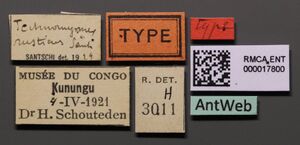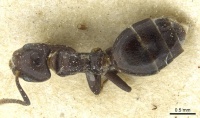Technomyrmex rusticus
| Technomyrmex rusticus | |
|---|---|

| |
| Scientific classification | |
| Kingdom: | Animalia |
| Phylum: | Arthropoda |
| Class: | Insecta |
| Order: | Hymenoptera |
| Family: | Formicidae |
| Subfamily: | Dolichoderinae |
| Genus: | Technomyrmex |
| Species: | T. rusticus |
| Binomial name | |
| Technomyrmex rusticus Santschi, 1930 | |
Known only from what are believed to be two intercaste type specimens that were mistakenly described as workers.
Identification
Keys including this Species
Distribution
Latitudinal Distribution Pattern
Latitudinal Range: -2.050343° to -2.050343°.
| North Temperate |
North Subtropical |
Tropical | South Subtropical |
South Temperate |
- Source: AntMaps
Distribution based on Regional Taxon Lists
Afrotropical Region: Democratic Republic of Congo (type locality).
Distribution based on AntMaps
Distribution based on AntWeb specimens
Check data from AntWeb
Countries Occupied
| Number of countries occupied by this species based on AntWiki Regional Taxon Lists. In general, fewer countries occupied indicates a narrower range, while more countries indicates a more widespread species. |

|
Estimated Abundance
| Relative abundance based on number of AntMaps records per species (this species within the purple bar). Fewer records (to the left) indicates a less abundant/encountered species while more records (to the right) indicates more abundant/encountered species. |

|
Biology
Castes
Intercaste?
   
| |
| . | |
Nomenclature
The following information is derived from Barry Bolton's Online Catalogue of the Ants of the World.
- rusticus. Technomyrmex rusticus Santschi, 1930a: 72, figs. 43-45 (w-q intercaste, not w.) DEMOCRATIC REPUBLIC OF CONGO. See also: Bolton, 2007a: 33.
Unless otherwise noted the text for the remainder of this section is reported from the publication that includes the original description.
Description
Worker-Queen Intercaste
Bolton (2007) - TL 3.7, HL 0.80, HW 0.79, SL 0.67, PW 0.56, WL 1.12. Indices: CI 99, SI 85, OI 32, EPI 63, DTI 132.
Frontal carina with a single seta: in profile at the level of the anterior portion of the eye; head posterior to this entirely lacks setae. Anterior clypeal margin with an extremely weak median concavity. Posterior margin of head shallowly impressed medially. Three small ocelli present. In full-face view the relatively large eye breaks the outline of the side of the head. Prominent fine elevated pubescence dense on the dorsal head and in full-face view clearly projecting from the sides both in front of and behind the eyes. Leading edge of scape with similar elevated pubescence but without setae. Dorsal mesosoma with fine dense pubescence but without setae. Lateral margins of propodeal declivity with 3 pairs of setae. Mesonotum separated into a large mesoscutum and a small but clearly differentiated mesoscutellum, conspicuous both in profile and in dorsal view. A narrow but elevated and prominent metanotum is present. Gastral tergites 1 - 3 without setae, tergite 4 with two pairs of setae present. Colour of head, mesosoma, petiole, gaster and all leg segments a very uniform dark brown.
It was thought that the lack of setae on gastral tergites 1 - 3 could be due to abrasion, but setal sockets have not been detected and distinct setae and their sockets remain on tergite 4, so lack of setae on tergites 1 - 3 must be considered as normal.
Type Material
Bolton (2007) - Syntype worker-queen intercaste (not worker), Democratic Republic of Congo: Kunungu, 4.iv.1921 (H. Schouteden) (Naturhistorisches Museum, Basel) [examined].
The surviving syntype, of an original two of this taxon, is a worker-queen intercaste, not a worker as stated in the original description. Small but distinct ocelli are present and the mesosoma has a differentiated mesoscutum and mesoscutellum, as well as a small but well-defined and prominent metanotum. From Santschi's (1930a) comments and figures I suspect that both were intercastes. The type-locality of Technomyrmex rusticus is the same as one of the series of moerens nigricans and the two samples were collected only two days apart, but because of the radically different distribution of setae between intercastes of moerens and rusticus, and other characters, I doubt that the latter is conspecific with the former.
References
- Bolton, B. 2007b. Taxonomy of the dolichoderine ant genus Technomyrmex Mayr (Hymenoptera: Formicidae) based on the worker caste. Contributions of the American Entomological Institute. 35(1): 1-149.
- Santschi, F. 1930a. Description de Formicides éthiopiens nouveaux ou peu connus. V. Bull. Ann. Soc. Entomol. Belg. 70: 49-77 (page 72, figs. 43-45 worker described)

